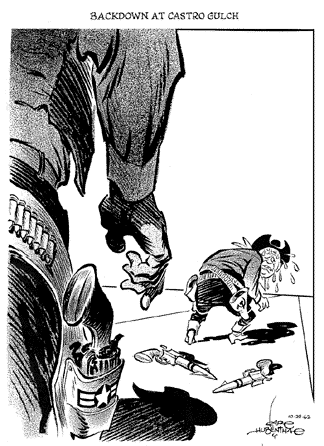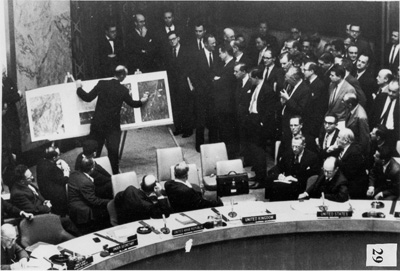The Potential War: The Cuban Missile Crisis
By: Diego Valenzuela, Brophy College Preparatory, United States History, Mr. Burns, Phoenix, Arizona
Sunday, May 8, 2011
Timeline for the Cuban Missile Crisis
Works Cited
Works Cited
Aakre, Nels and Silverman, Leslie. An Overview of the Crisis. Oracle Thinkquest. 1997. Web. 1 May 2011.
Aakre, Nels and Silverman, Leslie. Fourteen Days in October: The Cuban Missile Crisis. Oracle Thinkquest. 1997. Web. 1 May 2011.
Aakre, Nels and Silverman, Leslie. Adlai Stevenson. Oracle Thinkquest. 1997. Web. 4 May 2011.
Dobbs, Michael. Secret Heroes. Washingtonpost.com. 2003. Web. 2 May 2011.
Donaldson, Roger, dir. Thirteen Days. Perf. Kevin Costner, Bruce Greenwood, and Steven Culp. New Line Cinema, 2000. DVD.
Goldman, Jerry and Stein, Giel. The Cuban Missile Crisis, October 18-29, 1962. Northwestern University. 1997. Web. 1 May 2011.
History-Timeline.org. Cuban Missile Crisis Timeline. Google.com. 2011. Web. 1 May 2011.
John F. Kennedy Presidential Library and Museum. Cuban Missile Crisis. John F. Kennedy Presidential Library and Museum Archives. 2011. Web. 1 May 2011.
Kennedy, David. The American Pageant. Boston: Houghton Mifflin Company, 2006. Online Print.
Lander, Erik. Rudolf Anderson, Jr. Ancestry.com. 2003. Web. 2 May 2011.
Simkin, John. Bay of Pigs. Google.com. 2003. Web. 1 May 2011.
Simkin, John. Cuban Missile Crisis. Google.com. 2003. Web. 30 Apr. 2011.
Simkin, John. Operation Mongoose. Google.com. 2003. Web. 1 May 2011.
The National Security Archive. A Chronology of Events. The George Washington University. 1962. Web. 1 May 2011.
The National Security Archive. The Cuban Missile Crisis, 1962: The 40th Anniversary. The George Washington University. 2002. Web. 1 May 2011.
The National Security Archive. Declassified Documents. The George Washington University. 1962. Web. 1 May 2011.
Thinkexist.com. Dean Rusk Quotes. Google.com. 2010. Web. 3 May 2011.
Day 14 of the Cuban Missile Crisis


Considered the closest day that the United States was to a nuclear war, the events of October 28, 1962, the final day of the Cuban Missile Crisis, would change American and international politics forever. Beginning on the morning of Sunday, October 28, at six o’clock am, it was reported by the CIA that all of the Cubans ballistic missiles were operational and were in standby waiting for the signal by Khrushchev. In response to this action, President Kennedy allowed the Air Force to also move into position as several American F-102 fighter planes, armed with nuclear missiles, monitored the skies of the Bering Sea and Cuba. With a push of a button, nuclear warheads could have been launched to the Soviet Union and Cuba, resulting with a nuclear war. However, President Kennedy and Khrushchev met between the hours of six and nine o’clock am, and after their long discussion, war was averted. Both President Kennedy and Khrushchev had met each other’s demands, and people around the world began to rejoice. In his article, John Simkin explains that the terms to the agreement between the superpowers included that Khrushchev would remove the nuclear missiles from Cuba and all soviet troop would leave Cuba, while President Kennedy agreed to not invade Cuba or the Soviet Union and remove all missiles from Italy and Turkey (“Cuban Missile Crisis,” par. 24-28). It was also agreed upon that both nations would establish a direct communications link known as the Hot Line, in order to avoid future dangerous confrontations, and a Test Ban Treaty which prohibited the testing of nuclear weapons in the atmosphere (“Cuban Missile Crisis,” par. 24-26). Following the scare of the Cuban Missile Crisis, in the United States, President Kennedy, EX-COMM, and the JCS were praised as heroes for never backing down to the Soviets and for escaping World War III, while in the Soviet Union; Khrushchev faced much disappointment as he was never forgiven by his people for losing to America. Though the world had been saved by the actions of President Kennedy, EX-COMM, the JCS, and Khrushchev, the conflict known as the Cold would still exist between the Americans and Soviets for nearly three more decades until peace was finally achieved in 1989.
Blog Date: May 8, 2011
Historical Date: October 28, 1962
http://www.bobstaake.com/karl/images/hubie_edit_gulch.gif
http://www.virginiawestern.edu/faculty/vwhansd/his112/Images/NikitaK_JackKennedy.jpg
Day 13 of the Cuban Missile Crisis


With only around thirty more hours until the Soviet missiles in Cuba were fully operational, President Kennedy, EX-COMM, and the JCS were very eager to meet the demands of the Soviets and to protect the national security of the United States. While President Kennedy was responding to one of Khrushchev’s personal letters in order to ease the conflict, according to writer John Simkin, stakes were raised to an all-time high in the Cuban Missile Crisis, when the president received word that a U-2 plane, containing Major. Rudolf Anderson, had been shot down over Cuba (“Cuban Missile Crisis,” par. 21). Because of the Soviets actions in shooting down the lone U-2, President Kennedy was extremely angry and felt the absolute need to punish the Cubans and Soviets; however, he did not extract revenge, but instead he sent his personal letter to Khrushchev urging him to schedule an appointment with him the following day in Washington D.C. President Kennedy also informed the press about the talks with the Soviets because he wanted all Americans to be on high alert and to retreat to fallout shelters as soon as possible. In order to address the situation at hand, President Kennedy scheduled an immediate meeting with both the JCS and EX-COMM, and he made it clear that if any other planes were to be shot down, he would unquestionably launch nuclear missiles at the Cubans and the Soviets. In this meeting, according to professors Jerry Goldman and Giel Stein of Northwestern University, Secretary of Defense, Robert McNamara noted that if the Soviets continued to shoot down American planes, “We need to have two things ready, a government for Cuba…and plans for how to respond to the Soviet Union in Europe” (“The Cuban Missile Crisis, par. 149). Implying that the United States would invade Cuba, McNamara, President Kennedy, EX-COMM, and the JCS felt that an invasion of Cuba would be the only way to end the conflict, but there was still hope in the meeting between President Kennedy and Khrushchev that would become the deciding factor of the Cuban Missile Crisis.
Blog Date: May 8, 2011
Historical Date: October 27, 1962Day 12 of the Cuban Missile Crisis

From the findings at the U.N. meeting with Ambassador Stevenson and Zorin and the strong statements by the Soviets that disparaged the United States government, President Kennedy now felt that there were only two options besides only quarantining Cuba. According to a report by Professors Jerry Goldman and Giel Stein of Northwestern University, the first option, which the president favored, was to “negotiate them out, in other words trade them out” (“The Cuban Missile Crisis,” par. 100). In order to avoid this nuclear disaster, President Kennedy was willing to trade and take out his missiles in both Turkey and Italy while the Soviets and the Cubans had to remove their missiles from Cuba and the Soviet Union. In this scenario Khrushchev also wanted President Kennedy to “publicly guarantee that the United States will not invade Cuba” (“The Cuban Missile Crisis,” par. 88). The president found most of steps in this option to be favorable towards the United States, but he did not rule out the second plan, created by EX-COMM, which was to invade Cuba and forcibly remove the missiles from the country. Although the military leaders of the JCS found this a great opportunity for the United States to show their guns, President Kennedy seemed to back away from this option because he did not want to start World War III and because it was reported that approximately 18,500 soldiers were to become casualties during the first ten days of fighting in Cuba. Although President Kennedy wanted to negotiate with the Soviets in order to avoid a nuclear holocaust, his emotions swayed him to consider using an invasion because the Soviets did not want to listen to the pleas and proposed resolutions by the United States.
Blog Date: May 8, 2011
Historical Date: October 26, 1962
https://jspivey.wikispaces.com/file/view/bayofpigs.jpg/34477393/bayofpigs.jpg
Saturday, May 7, 2011
Day 11 of the Cuban Missile Crisis

Following his gut-wrenching meetings with both EX-COMM and the JCS, President Kennedy was on full alert and told military leaders to prepare their men for a likely invasion of Cuba. Adlai Stevenson also played a huge role as the American Ambassador to the United Nations when he questioned Soviet Ambassador to the United Nations, Valerian Zorin, on whether nuclear warheads were on the island of Cuba. In an article titled Adlai Stevenson on the website Thinkquest.org, during a conference at the United Nations, Ambassador Stevenson asked Ambassador Zorin if there were nuclear missiles on the Cuba, in which he denied, and Ambassador Stevenson calmly responded by stating, “You have denied that they exist, and I want to know whether I have understood you correctly. … I am prepared to wait for my answer until hell freezes over, if that’s your decision. And I am also prepared to present the evidence in this room” (“Adlai Stevenson,” par. 4). Immediately after stating this, several large photographs, taken by U-2 spy planes, were presented on national television, and these high quality pictures depicted the bomb assembly plants scattered throughout Cuba. Stunning millions of viewers and Ambassador Zorin alike, the American public now felt that an invasion was absolutely necessary because of the threat posed by the unstable Cubans and fiery Soviets. Tempers flared once again, and it would become worse for both the Americans and Soviets as the world continued to watch.
Blog Date: May 7, 2011
Historical Date: October 25, 1962
Day 10 of the Cuban Missile Crisis


With the commencement of the quarantine on October 24, 1962, American fears of the Soviet communists were at an all time high, and much of the public believed that the quarantine would result in World War III. Famed news icon, Walter Cronkite was even superstitious of the blockade of Cuba, and he warned Americans to pack their bags and flee to their nearest fallout shelter. Though people were skeptical of President Kennedy and his decision to place quarantine on Cuba, surprisingly, it was a huge success for the United States as only one ship, Bucharest, was allowed through because it was an oil carrier. When it was reported that the Soviet ships had stopped dead in their paths, according to a website named Thinkexist.com, Secretary of State, Dean Rusk, was ecstatic and proudly exclaimed, “We’re eyeball to eyeball and I think the other fellow just blinked” (“Dean Rusk quotes,” par. 1). On the brink of nuclear war, Soviet Premier Nikita Khrushchev was intimidated by the potential effects of barging through the quarantine and lost his first battle with the United States. In response to Khrushchev’s retreat, President Kennedy was relieved, for the time being, In fact, Khrushchev, in the document named A Chronology of Events by George Washington University, even proposed to President Kennedy a summit to “discuss how to end the conflict and remove the threat of the unleashing of a thermonuclear war” (“A Chronology of Events,” par. 87). Though some tensions were eased for a few moments, under the direction of the JCS, the Strategic Air Command, or SAC, raised the alertness of the nation by increasing the DEFCON level to 2, the highest it had been in the history of the United States. Again, the United States was getting much closer to a full-scale nuclear war with the Soviets, and the American public demanded answers to their hundreds of questions.
Blog Date: May 7, 2011
Historical Date: October 24, 1962
http://ts2.mm.bing.net/images/thumbnail.aspx?q=545039001673&id=f441627ae0a6ee584ed465e7f938bcb9
http://jspivey.wikispaces.com/file/view/cuban-blockade-map.jpg/34487747/cuban-blockade-map.jpg